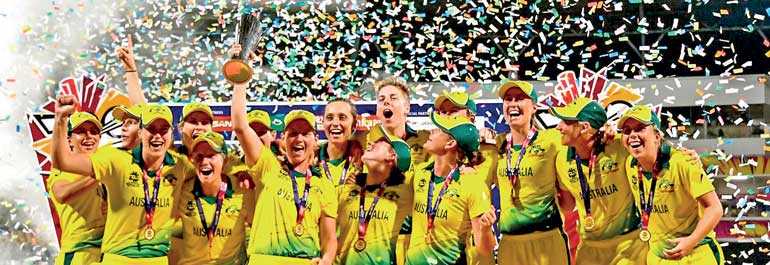Sunday Mar 16, 2025
Sunday Mar 16, 2025
Tuesday, 27 November 2018 00:00 - - {{hitsCtrl.values.hits}}

Melbourne (Reuters): In a year blighted by a ball-tampering scandal that brought the Australian men’s cricket team to its knees, the nation’s women have given fans no small reason to cheer.
Meg Lanning’s team secured their fourth World Twenty20 trophy in Antigua on Saturday, thrashing England by eight wickets to earn plaudits at home and abroad.
Though being paid a fraction of their male counterparts, the team’s achievements stand at odds with the men, who have lurched to four series losses across test and one-day formats since ‘sandpaper-gate’ broke in Cape Town in March.
With the next Twenty20 World Cup only 14 months away on home soil, Lanning speaks of dynasty-building in much the same way men’s captains Mark Taylor, Steve Waugh and Ricky Ponting did in decades past.
“We want to be a very consistent cricket team and I think we have done that over the last few years without the success at world tournaments,” Lanning said. “So hopefully this win is sort of the start of something. I’ve got no doubt that this group is capable of something special. The T20 World Cup is in Australia in 2020, which is going to be massive (and) I think we’ve shown that we can be the world’s best team.”
The Antigua triumph was a ray of light in another gloomy weekend for Australian elite sport, coming hours after the men’s rugby team was walloped by England in London to complete their worst test season in 60 years.
Shortly after Lanning hoisted the winner’s trophy, Aaron Finch’s men’s T20 side were thrashed by six wickets in Sydney by Virat Kohli’s India.
The result meant the teams split their three-match series 1-1 but Australia were probably fortunate that rain washed out the second match after they suffered a characteristic batting collapse.
Three of Australia’s top men players remain suspended from the ball-tampering episode, including Captain Steve Smith and Vice-captain David Warner.
Lanning’s team, however, have been an exemplar of sportsmanship on and off the field, and have little need for the puffed-up aggression that made the men’s side one of the game’s least likeable.
That may be because only a few years ago, Australia’s top women needed jobs to support their cricketing ambitions, a burden unimaginable to most male professionals, said star all-rounder Ellyse Perry.
“In some ways, I think that gives you a bit of a grounding and real level-headedness that potentially — through absolutely no fault of their own — the guys haven’t had in the last 10 or 15 years because the game is so demanding and they’re travelling 11 months of the year,” she told British media.
In the new collective bargaining agreement struck last year, the women’s team saw payments increase to AUD 55.2 million from AUD 7.5 million ($5.44 million) over the life of a five-year deal.
While still only a small slice of the total forecast payments pool of AUD 459 million, the extra funding has already led to welcome results and is in no way taken for granted.
“There’s no doubt that being professional allows us to put everything we can into becoming better cricketers and better people off the field as well,” said Lanning. “We’re very lucky that we’ve got the support network behind the scenes to allow us to do that. And we just love what we do. I guess it’s a job but, gee, it’s a good one to do.”
Discover Kapruka, the leading online shopping platform in Sri Lanka, where you can conveniently send Gifts and Flowers to your loved ones for any event including Valentine ’s Day. Explore a wide range of popular Shopping Categories on Kapruka, including Toys, Groceries, Electronics, Birthday Cakes, Fruits, Chocolates, Flower Bouquets, Clothing, Watches, Lingerie, Gift Sets and Jewellery. Also if you’re interested in selling with Kapruka, Partner Central by Kapruka is the best solution to start with. Moreover, through Kapruka Global Shop, you can also enjoy the convenience of purchasing products from renowned platforms like Amazon and eBay and have them delivered to Sri Lanka.
Discover Kapruka, the leading online shopping platform in Sri Lanka, where you can conveniently send Gifts and Flowers to your loved ones for any event including Valentine ’s Day. Explore a wide range of popular Shopping Categories on Kapruka, including Toys, Groceries, Electronics, Birthday Cakes, Fruits, Chocolates, Flower Bouquets, Clothing, Watches, Lingerie, Gift Sets and Jewellery. Also if you’re interested in selling with Kapruka, Partner Central by Kapruka is the best solution to start with. Moreover, through Kapruka Global Shop, you can also enjoy the convenience of purchasing products from renowned platforms like Amazon and eBay and have them delivered to Sri Lanka.